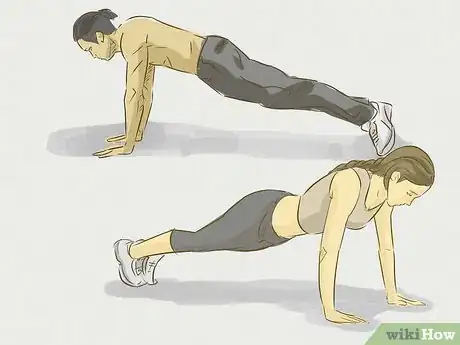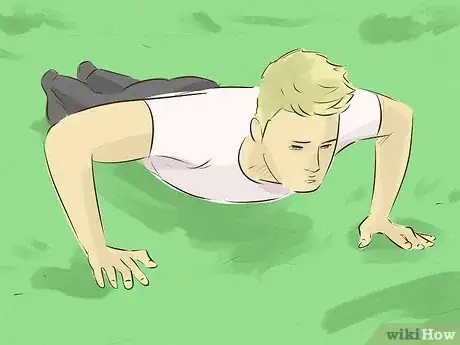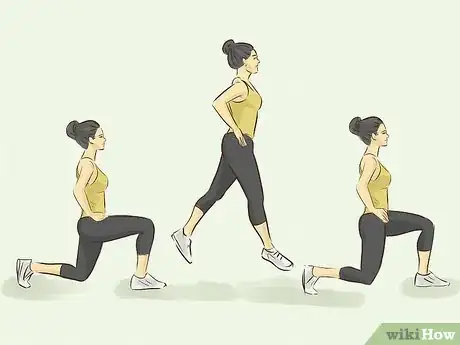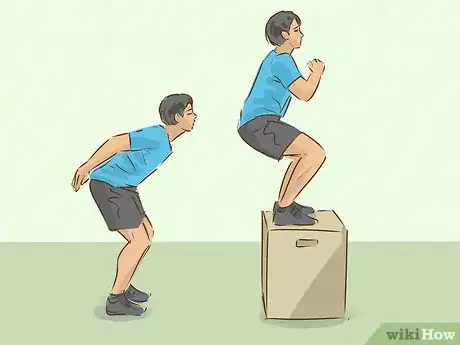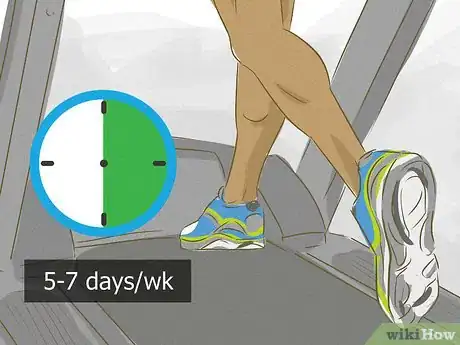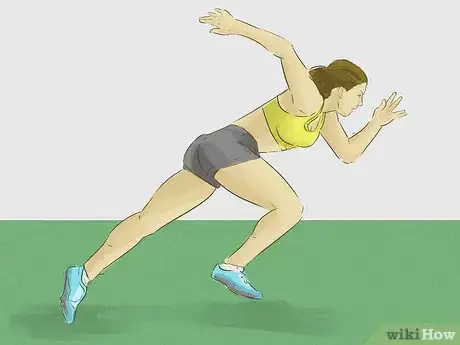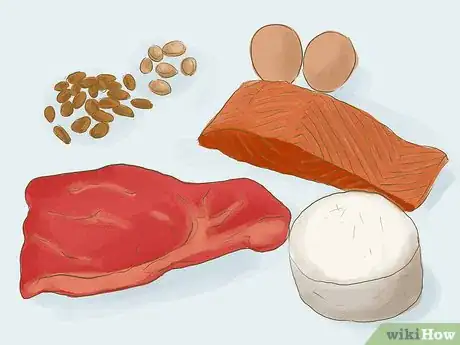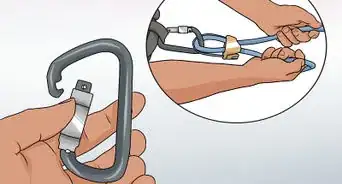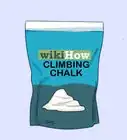This article was co-authored by Erika Noble and by wikiHow staff writer, Danielle Blinka, MA, MPA. Erika Noble graduated from Stanford University with a BS in Management Science & Engineering. After competing in collegiate rock climbing competitions as part of the Stanford Rock Climbing team, Erika worked as a Rock Climbing Instructor in Lake Tahoe. She continues to boulder and climb throughout California and the Southwest.
There are 9 references cited in this article, which can be found at the bottom of the page.
This article has been viewed 104,359 times.
Rock climbing is a fun but challenging sport, and being fit will help you climb safely. Getting in good shape for rock climbing requires both strength training and cardio, as you’ll need both for climbing. It’s also best to eat a healthy, balanced diet that fuels you and your workouts. With hard work and determination, you can climb higher and longer!
Steps
Strengthening Your Upper Body and Core
-
1Do finger hangs to strengthen your hands and improve your grip. Use a sturdy door frame or a low tree branch. Lift yourself onto your toes and grip the door frame or branch with the top half of your fingers. Lift your legs so that you’re hanging. Let yourself hang for 5 seconds, then release and rest for 5 seconds.[1]
- Repeat the exercise for 1 minute, which means you should do 6 reps total.
- Use the pads on the top half of your fingers to hold you up.
- This exercise will help you get used to supporting your weight on a ledge.
Expert AnswerQWhen asked, "How often do you do finger strength exercises?"
Erika Noble graduated from Stanford University with a BS in Management Science & Engineering. After competing in collegiate rock climbing competitions as part of the Stanford Rock Climbing team, Erika worked as a Rock Climbing Instructor in Lake Tahoe. She continues to boulder and climb throughout California and the Southwest.PCIA Certified Rock Climbing Instructor
 EXPERT ADVICEAnswer from Erika Noble:
EXPERT ADVICEAnswer from Erika Noble:Erika Noble, rock climbing instructor, responded: "I try to do finger-strengthening exercises every other day, at most. I like to vary my training and hang board at the end of my sessions. Remember — while strengthening your fingers is key to improving your climbing, you want to be careful not to overdo it. Finger injuries can keep you sidelined for weeks or months at a time. Find a schedule that's reasonable, sustainable, and works for you."
-
2Perform pull-ups to build arm and shoulder strength. Grip a stable bar with your hands shoulder-width apart. You can use an overhanded or underhanded grip. Bend your legs behind you so that you’re hanging from the bar, then slowly pull yourself up. Raise your chin above the bar, then lower yourself slowly back to start. Make sure your muscles are controlled and engaged the entire time.[2]
- Do 2-3 sets of 6-10 pull-ups.
- To increase the challenge and build more strength, pull yourself up as quickly as you can, then slowly lower yourself for a 5 count.
- Alternatively, do chin-to-knuckle pull-ups by pulling yourself up to 1 side. Touch your chin to the top of your knuckle, then release. Alternate sides as you do your pull-ups to mimic the movement of rock climbing.
Expert AnswerQWhen asked, "What are the best rock climbing exercises?"
Erika Noble graduated from Stanford University with a BS in Management Science & Engineering. After competing in collegiate rock climbing competitions as part of the Stanford Rock Climbing team, Erika worked as a Rock Climbing Instructor in Lake Tahoe. She continues to boulder and climb throughout California and the Southwest.PCIA Certified Rock Climbing Instructor
 EXPERT ADVICEAnswer from Erika Noble:
EXPERT ADVICEAnswer from Erika Noble:Erika Noble, rock climbing instructor, responded: "Pull-ups and lat pull-downs are two great exercises for climbing since they target the large lat muscles in your back. Shoulder presses, lateral raises, and rear deltoid flys will target your shoulders and delts which are key stabilizing muscles for climbing."
Advertisement -
3Do planks to build your upper body and core strength simultaneously. Planks help you build the strength you need to hold yourself up and support your own weight while you're climbing. Lie on your stomach, then get into push-up position with your palms directly under your shoulders. Slowly push yourself off the ground, balancing your weight on your palms and toes. Keep your core tightened to support a straight back. Hold the plank for as long as you can or up to 2 minutes.[3]
- If you can’t hold your plank for 2 minutes, hold it as long as you can. Then, rest and repeat until you’ve held a plank for a total of 2 minutes.
- Don’t let your back slouch or stick up your butt while you’re doing your planks.
Variation: As you get stronger, try to rise up onto your fingers during your planks. This will help you build your hand strength for rock climbing.
-
4Perform push-ups for a more intense core and upper body workout. Push-ups help you build the muscles you need to lift and lower your body weight. Lie down on your stomach, then place your hands under your shoulders. Engage your core, then slowly push yourself off the floor. Balance on your palms and toes, keeping your back straight. Hold for 2-3 seconds, then slowly lower yourself down to the floor.[4]
- Do 1-3 sets of 10 push-ups.
- Don’t point your butt up into the air or let your back slouch.
- To make your body work harder, try putting your hands slightly above your head. Form a diamond shape with your hands, angling your elbows outward. These are called diamond or superman push-ups.
- To make your push-ups more challenging, do them on an incline. Put your feet on a chair, stair, or sturdy box, but keep your lower body on the ground. Slowly perform your push-ups in this position.
EXPERT TIP"Round out your training with push-ups and dips to target your triceps and avoid climber's elbow."
Erika Noble graduated from Stanford University with a BS in Management Science & Engineering. After competing in collegiate rock climbing competitions as part of the Stanford Rock Climbing team, Erika worked as a Rock Climbing Instructor in Lake Tahoe. She continues to boulder and climb throughout California and the Southwest.
Erika Noble
PCIA Certified Rock Climbing Instructor Erika Noble
Erika Noble
PCIA Certified Rock Climbing Instructor -
5Go to a rock climbing gym and climb the beginner wall. This will help you get practice with climbing while you build up your strength. Tell the employees you’re a beginner and what your goals are. They’ll help you pick the right course for you.[5]
- It’s a good idea to visit the rock climbing gym 2-3 times a week as you build up your strength. You don’t need to wait until you’ve built up your fitness to do beginner climbs.
Building Your Leg Strength
-
1Perform single-leg pistol squats for strong, flexible legs. Stand with your feet hip-width apart and your arms extended out in front of you. Extend your left leg out in front of you with your knee straight, your toe pointed, and your foot not touching the floor. Slowly lower your body down by bending your right leg. Keep your right knee in line with your foot, not letting it go out past your toe. Hold for 30 seconds if you can, then slowly rise back to your starting position.[6]
- Do 1-3 sets of 5-10 pistol squats on each side.
- Hold the squat for as long as you can. If you need help balancing, hold onto a chair or the wall.
- Your legs need to be strong and flexible so you can propel yourself up the wall or summit.
-
2Perform jumping lunges to build explosive strength for climbing. Step forward with your right leg, then slowly lower yourself down by bending your right knee. Keep your knee in line with your foot and don’t extend it past your toe. Then, explode off the floor, jumping back into your starting position. Repeat on the other side.[7]
- Do 1-3 sets of 8-10 jumping lunges on each side.
-
3Do box jumps to strengthen your legs for propelling yourself upward. Stand with your feet hip-width apart in front of a sturdy box. Lower your body into a slight squat and swing your arms back. Then, swing your arms forward and propel yourself up onto the box, landing in a slight squat. Finally, jump back down to your starting position.[8]
- Do 1-3 sets of 3-6 box jumps.
Improving Your Cardio Fitness
-
1Get 30 minutes of cardio exercise 5-7 days a week to build endurance. Cardio activity will help condition your body and improve your endurance level. In fact, it’s best to get at least 150 minutes of moderate cardio activity each week to maintain a healthy body. Make sure you do your cardio exercise 5-7 days a week. For instance, you might try the following cardio exercises:[9]
Tip: It’s best to rest for 1-2 days a week, depending on your fitness goals and endurance levels. You may want to take a slow walk on your rest days so that you’re still being active.
-
2Do short sprints to improve your fitness so you can climb longer. Mark off a distance of about 100 feet (30 m), and place additional markers every 10 feet (3.0 m). Sprint from the start to the finish and touch the baseline. Then, sprint back to start and touch the baseline. Turn back around and sprint to your 2nd-to-last 10 ft (3.0 m) marker. Continue sprinting back and forth until you’ve touched each baseline and run back.[10]
- Shorten your sprint by 10 ft (3.0 m) on each turnaround.
Variation: As an alternative, you can do interval training instead. Sprint for 1 minute, then jog or walk for 1-2 minutes. Repeat for at least 10 minutes or up to 30 minutes.
-
3Walk up and down stairs with weights to simulate climbing. Wear a weighted vest or a heavy backpack or carry hand weights. Walk up at least 1 flight of stairs, then walk back down. Continue climbing up and down the stairs for at least 10 minutes. Go as fast as you safely can.[11]
- Try to go for 30 minutes.
- This will help you build your climbing endurance.
Variation: As another option, you can run up and down the stairs without weights. This will also help you build your endurance and condition your body for climbing.
Eating a Healthy Diet
-
1Get 50-60% of your calories from healthy carbohydrates (carbs). Choose nutritious, complex carbs for most of your meals to help fuel your body during your workouts and recovery.[12] The best sources of carbs include vegetables, fruits, beans, legumes, and whole grains. Include these foods in each of your meals.[13]
- For example, you might eat oatmeal for breakfast, a salad at lunch, apple slices for a snack, and lentil soup for dinner.
- To figure out how many grams of carbs to eat, multiply your calorie goal by .5 for 50% or .6 for 60%, then divide by 4 because there’s 4 calories in a gram of carbs. For instance, if you planned to eat 2,000 calories a day, you’d multiply 2,000 x .5 = 1,000. Then, divide 1,000/4 = 250. This means you’d eat 250 grams of carbohydrates a day.
-
2Make 30-35% of your calories lean protein. Protein helps your body repair and fuel your muscles, so it’s an essential nutrient.[14] Choose lean options like poultry, fish, low-fat dairy, beans, legumes, nuts, tofu, or veggie burgers. Eat a source of lean protein at each meal.[15]
- For example, you might add 1% milk and sliced almonds to your oatmeal at breakfast, grilled chicken to your salad at lunch, and peanut butter to your apple slices. Lentils contain protein, so you’d already be eating protein if you were eating lentil soup.
- To calculate how much protein you need, multiple your calorie goal by .3 or .35, then divide by 4. For a calorie goal of 2,000, multiply 2,000 x .3 = 600. Then, divide 600/4 = 150. You’d eat 150 grams of protein.
-
3Get 20-25% of your calories from healthy fats. Your body needs fat to stay healthy and recover after your workouts.[16] However, you want to choose healthy fats, such as monounsaturated fats, polyunsaturated fats, and omega-3s.[17] However, eat fewer saturated fats and avoid trans fats. Get most of your fats from fatty fish, nuts, natural oils, avocado, and peanut butter.[18]
- For instance, you’d get fat from the sliced almonds on your oatmeal, the salad dressing on your salad, and the peanut butter you ate as your snack. You can add fat to your lentil soup by sauteing your aromatic soup veggies, like onions and garlic, in oil before you make the soup or by sprinkling cheese over your soup.
- To figure out how much fat you need each day, multiply your calorie goal by .2 or .25, then divide by 9 because there’s 9 calories in a gram of fat. For a 2,000 calorie goal, you’d multiply 2,000 x .2 = 400. Then, divide 400/9=44.4. You could round this to 44 grams of fat per day.
-
4Eat about 25-30 g of nutritious carbs 30 minutes before a climb. Carbs fuel your body, especially during a hard workout. You don’t want to feel full, but eating a light high-carb snack can give you the power to complete your workout. Stick to healthy, nutritious carbs, like fruits, veggies, and whole grains.[19]
- If you’re going on a short climb, choose easy-to-digest carbs like bananas, dried fruit, oats, or sweet potatoes.
- For longer climbs, opt for complex carbs, such as brown rice, beans, or quinoa.
- It’s best to avoid sugar packs or processed snacks, as these don’t contain as many nutrients.
-
5Consume protein and carbs within 30 minutes of working out. Choose a snack that’s high in protein and carbs but has less than 5 grams of fat. This will help refuel your body post-workout so your muscles can recover and rebuild.[20]
- For instance, you might drink a protein shake, eat Greek yogurt with cut up fruit, or snack on string cheese and a serving of grapes.
-
6Drink at least 8 to 10 cups (1.9 to 2.4 L) of water daily to stay hydrated. Your body needs plenty of fluids to fuel your workouts, maintain your body, and recover post-workout. Sip on water throughout your day, and add in more foods that hydrate you, such as fruits or soup.[21]
- If you don’t like water, try flavoring it with sliced fruit. As another alternative, you can drink tea or other fluids instead.
- Since you’re likely very active, you may need more water every day. Increase your water intake if you feel thirsty or tired.
Community Q&A
-
QuestionWhat should I wear for climbing?
 Community AnswerWear athletic clothes that you can easily move in. Avoid jeans because they make climbing difficult.
Community AnswerWear athletic clothes that you can easily move in. Avoid jeans because they make climbing difficult. -
QuestionWhat if you are too busy to make time for healthy eating?
 Mahika KumarCommunity AnswerThere are plenty of ways to eat healthily and still have time. I too have a fairly busy life, even in quarantine and it is pretty simple. Having a healthy diet is very important in life in general. ating healthy doesn't mean eating full freshly cooked meals. Eat some nuts or fruit throughout the day. Just try to create healthy habits and you'll eventually have time for healthy eating.
Mahika KumarCommunity AnswerThere are plenty of ways to eat healthily and still have time. I too have a fairly busy life, even in quarantine and it is pretty simple. Having a healthy diet is very important in life in general. ating healthy doesn't mean eating full freshly cooked meals. Eat some nuts or fruit throughout the day. Just try to create healthy habits and you'll eventually have time for healthy eating.
Warnings
- Try not to be intimidated by better climbers. Instead, ask them for advice. Remember, they were once where you are.⧼thumbs_response⧽
- Don’t attempt any outdoor climbing without first learning all the basics of safety.⧼thumbs_response⧽
- If you feel a little too much strain in your hands, stop training and take a week or 2 to let them recover.⧼thumbs_response⧽
References
- ↑ https://www.climbing.com/skills/training-gym-free-climbing-exercises-you-can-do-anywhere/
- ↑ https://www.esquire.com/uk/culture/news/a5191/how-to-get-in-shape-for-rock-climbing/
- ↑ https://www.climbing.com/skills/training-gym-free-climbing-exercises-you-can-do-anywhere/
- ↑ https://www.climbing.com/skills/training-gym-free-climbing-exercises-you-can-do-anywhere/
- ↑ https://dailyburn.com/life/fitness/rock-climbing-workouts/
- ↑ https://www.climbing.com/skills/training-gym-free-climbing-exercises-you-can-do-anywhere/
- ↑ https://www.climbing.com/skills/training-gym-free-climbing-exercises-you-can-do-anywhere/
- ↑ https://www.climbing.com/skills/training-gym-free-climbing-exercises-you-can-do-anywhere/
- ↑ https://rockandice.com/rock-climbing-training/general-conditioning-for-climbers/
- ↑ https://www.climbing.com/skills/training-gym-free-climbing-exercises-you-can-do-anywhere/
- ↑ https://www.climbing.com/skills/training-gym-free-climbing-exercises-you-can-do-anywhere/
- ↑ https://www.climbing.com/skills/nutrition-essentials-for-climbers/
- ↑ https://www.medicalnewstoday.com/articles/318615.php
- ↑ https://www.climbing.com/skills/nutrition-essentials-for-climbers/
- ↑ https://www.choosemyplate.gov/protein-foods-tips
- ↑ https://www.climbing.com/skills/nutrition-essentials-for-climbers/
- ↑ https://www.mayoclinic.org/healthy-lifestyle/nutrition-and-healthy-eating/in-depth/fat/art-20045550
- ↑ https://www.eatright.org/food/nutrition/dietary-guidelines-and-myplate/choose-healthy-fats
- ↑ https://www.climbing.com/skills/nutrition-essentials-for-climbers/
- ↑ https://www.climbing.com/skills/nutrition-essentials-for-climbers/
- ↑ https://www.climbing.com/skills/nutrition-essentials-for-climbers/
About This Article
To get in shape for rock climbing, practice hanging from a sturdy door frame or tree branch for a few seconds at a time to improve your grip and hand strength. You should also do pull-ups, which build your arm and shoulder strength. Other good exercises you should practice are push-ups and planks to improve your core and upper body. In addition to building muscle, schedule time for cardio exercises, like jogging, cycling, or swimming, to improve your overall endurance. For more tips from our Rock Climbing co-author, including how to manage your diet in preparation for rock climbing, read on!


